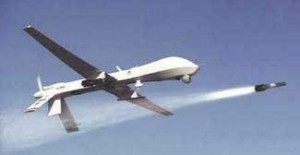 The United States is quietly rushing dozens of Hellfire missiles and low-tech surveillance drones to Iraq to help government forces combat an explosion of violence by a Qaeda-backed insurgency that is gaining territory in both western Iraq and neighboring Syria.
The United States is quietly rushing dozens of Hellfire missiles and low-tech surveillance drones to Iraq to help government forces combat an explosion of violence by a Qaeda-backed insurgency that is gaining territory in both western Iraq and neighboring Syria.
The move follows an appeal for help in battling the extremist group by the Iraqi prime minister, Nuri Kamal al-Maliki, who met with President Obama in Washington last month.
But some military experts question whether the patchwork response will be sufficient to reverse the sharp downturn in security that already led to the deaths of more than 8,000 Iraqis this year, 952 of them Iraqi security force members, according to the United Nations, the highest level of violence since 2008.
Al Qaeda’s regional affiliate, the Islamic State in Iraq and Syria, has become a potent force in northern and western Iraq. Riding in armed convoys, the group has intimidated towns, assassinated local officials, and in an episode last week, used suicide bombers and hidden explosives to kill the commander of the Iraqi Army’s Seventh Division and more than a dozen of his officers and soldiers as theyraided a Qaeda training camp near Rutbah.
Bombings on Christmas in Christian areas of Baghdad, which killed more than two dozen people, bore the hallmarks of a Qaeda operation.
The surge in violence stands in sharp contrast to earlier assurances from senior Obama administration officials that Iraq was on the right path, despite the failure of American and Iraqi officials in 2011 to negotiate an agreement for a limited number of United States forces to remain in Iraq.
In a March 2012 speech, Antony J. Blinken, who is currently Mr. Obama’s deputy national security adviser, asserted that “Iraq today is less violent” than “at any time in recent history.”
In contrast, after a recent spate of especially violent attacks against Iraqi forces, elected officials and civilians, Jen Psaki, the State Department spokeswoman, issued a strongly worded statement on Sunday warning that the Qaeda affiliate is “seeking to gain control of territory inside the borders of Iraq.”
Pledging to take steps to strengthen Iraqi forces, Ms. Psaki noted that the Qaeda affiliate was a “common enemy of the United States and the Republic of Iraq, and a threat to the greater Middle East region.”
But the counterterrorism effort the United States is undertaking with Iraq has its limits.
Iraq’s foreign minister has floated the idea of having American-operated, armed Predator or Reaper drones respond to the expanding militant network. But Mr. Maliki, who is positioning himself to run for a third term as prime minister and who is sensitive to nationalist sentiment at home, has not formally requested such intervention.
The idea of carrying out such drone attacks, which might prompt the question of whether the Obama administration succeeded in bringing the Iraq war to what the president has called a “responsible end,” also appears to have no support in the White House.
“We have not received a formal request for U.S.-operated armed drones operating over Iraq, nor are we planning to divert armed I.S.R. over Iraq,” said Bernadette Meehan, a spokeswoman for the National Security Council, referring to intelligence, surveillance and reconnaissance missions. For now, the new lethal aid from the United States, which Iraq is buying, includes a shipment of 75 Hellfire missiles, delivered to Iraq last week. The weapons are strapped beneath the wings of small Cessna turboprop planes, and fired at militant camps with the C.I.A. secretly providing targeting assistance.
In addition, 10 ScanEagle reconnaissance drones are expected to be delivered to Iraq by March. They are smaller cousins of the larger, more capable Predators that used to fly over Iraq.
American intelligence and counterterrorism officials say they have effectively mapped the locations and origins of the Qaeda network in Iraq and are sharing this information with the Iraqis.
Administration officials said the aid was significant because the Iraqis had virtually run out of Hellfire missiles. The Iraqi military, with no air force to speak of and limited reconnaissance of its own, has a very limited ability to locate and quickly strike Qaeda militants as they maneuver in western and northern Iraq. The combination of American-supplied Hellfire air-to-ground missiles, tactical drones and intelligence, supplied by the United States, is intended to augment that limited Iraqi ability.
The Obama administration has given three sensor-laden Aerostat balloons to the Iraqi government, provided three additional reconnaissance helicopters to the Iraqi military and is planning to send 48 Raven reconnaissance drones before the end of 2014. And the United States is planning to deliver next fall the first of the F-16 fighters Iraq has bought.
The lack of armed drones, some experts assert, will hamper efforts to dismantle the Qaeda threat in Iraq over the coming weeks and months.
“Giving them some ScanEagle drones is great,” said Michael Knights, an expert on Iraqi security at the Washington Institute for Near East Policy. “But is it really going to make much difference? Their range is tiny.”
“The real requirement today is for a long-range, high-endurance armed drone capability,” added Mr. Knights, who frequently travels to Iraq. “There is one place in the world where Al Qaeda can run a major affiliate without fear of a U.S. drone or air attack, and that is in Iraq and Syria.
NY Times
Leave a Reply
You must be logged in to post a comment.